Dear Zazie, Here is today’s Lovers’ Chronicle from Mac Tag to his muse. Follow us on twitter @cowboycoleridge. Hope you have a good Valentine’s Day. Rhett
The Lovers’ Chronicle
Dear Muse,
“This day more than any other”
yes i have carried on,
perhaps too on, on this day
“Said with many words or a few”
the bein’ and feelin’ is what matters
“Still mine”
on this day and any other
each a gift we should hold close
“Oh yes my favorite part”
that which does not alter or bend
© copyright 2023 mac tag/cowboy coleridge all rights reserved
© copyright 2021 mac tag/cowboy coleridge all rights reserved
never say, well not sure
about that, or the truth
does absence of either
indicate as much
could no more part from this,
which in you doth lie, the only
home, ever should have known
a traveler, returnin’,
to the places, of you,
for you, with you, to you
© copyright 2019 mac tag/cowboy coleridge all rights reserved
be mine
if only
for a little while
take my hand
stay
just long enough
so i can recall
what it was like
© copyright 2018 mac tag/cowboy coleridge all rights reserved
In honour of Valentine’s Day; three poems, and day in history notes.
Sonnet 109: O! never say that I was false of heart
O never say that I was false of heart,
Though absence seemed my flame to qualify.
As easy might I from myself depart,
As from my soul, which in thy breast doth lie.
That is my home of love; if I have ranged
Like him that travels I return again,
Just to the time, not with the time exchanged,
So that myself bring water for my stain.
Never believe, though in my nature reigned
All frailties that besiege all kinds of blood,
That it could so preposterously be stained
To leave for nothing all thy sum of good—
For nothing this wide universe I call,
Save thou, my rose; in it thou art my all.
– “Sonnet 109” by William Shakespeare. Public domain.
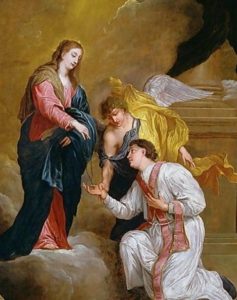 On Valentine’s Day we celebrate romantic love. The holiday was named after an early Christian priest, St. Valentine, who was martyred on 14 February 269 A.D.
On Valentine’s Day we celebrate romantic love. The holiday was named after an early Christian priest, St. Valentine, who was martyred on 14 February 269 A.D.
The tradition of exchanging love notes on Valentine’s Day originates from the martyr Valentine himself. The legend maintains that due to a shortage of enlistments, Emperor Claudius II forbade single men to get married in an effort to bolster his struggling army. Seeing this act as a grave injustice, Valentine performed clandestine wedding rituals in defiance of the emperor. Valentine was discovered, imprisoned, and sentenced to death by beheading. While awaiting his fate in his cell, it is believed that Valentine fell in love with the daughter of a prison guard, who would come and visit him. On the day of his death, Valentine left a note for the young woman professing his undying devotion signed “Love from your Valentine.”
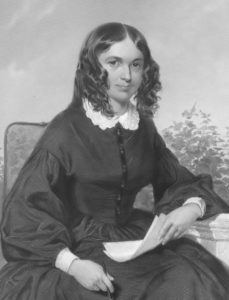 Poets Robert Browning and Elizabeth Barrett Browning carried out one of the most famous romantic correspondences in literary history. They first introduced themselves by epistolary means, and fell in love even before they had met in person. The letter that began their relationship was written by Robert in January 1845; it was essentially a piece of fan mail to esteemed poet Elizabeth Barrett. He wrote:
Poets Robert Browning and Elizabeth Barrett Browning carried out one of the most famous romantic correspondences in literary history. They first introduced themselves by epistolary means, and fell in love even before they had met in person. The letter that began their relationship was written by Robert in January 1845; it was essentially a piece of fan mail to esteemed poet Elizabeth Barrett. He wrote:
“I love your verses with all my heart, dear Miss Barrett — and this is no offhand complimentary letter that I shall write — whatever else, no prompt matter-of-course recognition of your genius and there a graceful and natural end of the thing: since the day last week when I first read your poems, I quite laugh to remember how I have been turning and turning again in my mind what I should be able to tell you of their effect upon me …”
Barrett responded right away: “I thank you, dear Mr Browning, from the bottom of my heart. … Such a letter from such a hand!”
They continued writing to each other, clandestinely, for a year and a half, and then they secretly got married in 1846. Right before the wedding, Robert mailed off to Elizabeth a letter that said: “Words can never tell you, however, — form them, transform them anyway, — how perfectly dear you are to me — perfectly dear to my heart and soul. I look back, and in every one point, every word and gesture, every letter, every silence — you have been entirely perfect to me — I would not change one word, one look. I am all gratitude — and all pride (under the proper feeling which ascribes pride to the right source) all pride that my life has been so crowned by you.”
And then, the day after the wedding, she wrote to him:
“What could be better than [your] lifting me from the ground and carrying me into life and the sunshine? … All that I am, I owe you — if I enjoy anything now and henceforth, it is through you.”
During their courtship, she was composing sonnets for him, which she presented to him as a wedding gift. The sonnets were published in 1850 and include one of Elizabeth Barrett Browning’s most famous love poems:
How do I love thee? Let me count the ways.
I love thee to the depth and breadth and height
My soul can reach, when feeling out of sight
For the ends of being and ideal Grace.
I love thee to the level of everyday’s
Most quiet need, by sun and candlelight.
I love thee freely, as men strive for Right.
I love thee purely, as they turn from Praise.
I love thee with the passion put to use
In my old griefs, and with my childhood’s faith.
I love thee with a love I seemed to lose
With my lost saints — I love thee with the breath,
Smiles, tears, of all my life! — and, if God choose,
I shall but love thee better after death.
All of the above inspired the following:
All My Love
Never say my heart was not true,
Though absence may indicate as much
I could no more part from myself
As from my soul, which in you doth lie
You will always be the home of my love
I have rode and ranged far and wide
But like a traveler, I return again,
Back to the time, back to the places,
Of you, for you, with you, to you
Never believe, though in my nature reigns
This wanderin’ soul that haunts my blood,
That I forsake you, wherever I roam,
For I carry your memory with me always
For no one in this world do I call,
Save you, my one; in it you are my all
These verses I write with all my heart
I have been turnin’ and turnin’ again
In my mind how I should be able
To tell you of your effect upon me…
Thank you, from the bottom of my heart
Such a woman, such as I never expected
Words can never tell you; however
Form them, transform them anyway,
How dear you are to my heart and soul
I look back, and in every point in time,
Every word and gesture, every letter,
Every silence, you have been perfect to me
I would not change one word, one look
I am all gratitude, and all pride to say
That my life has been crowned by you
What could be better; you lifted me up
From the depths and carried me into life
All that I am, all my words, I owe you
If I enjoy anything again, it is through you
I love you in every way possible
From every depth and breadth and height
Clear out of sight and as far as I can reach
From the beginnin’ of Grace to the end of bein’
I love you from everyday’s most quiet need,
Everyday before the sun and beyond candlelight
I walk the line because of my love for you
I give praise for you and the purity of my love
My love is so full of passion that it puts to rest
My old griefs, and restores all of my lost faith
I love you with a love I thought I had lost
With my lost soul, I love you through it all,
Smiles, tears, all my life and, with these words,
I shall but love you beyond my last breath
The Song of the Day is “All My Love” by Led Zeppelin. We do not own the rights to this song. All rights reserved by the rightful owner. No copyright infringement intended.
| Nina Hamnett | |
|---|---|

1917 portrait of Nina Hamnett painted by Roger Fry (Courtauld Gallery, London)
|
|
Today is the birthday of Nina Hamnett (Tenby, Pembrokeshire, Wales 14 February 1890 – 16 December 1956 London); artist and writer, and an expert on sailors’ chanteys, who became known as the Queen of Bohemia.
While studying in London she met and posed for Henri Gaudier-Brzeska who sculpted a series of nude bronzes. During this period she became friendly with Olivia Shakespear and Ezra Pound. She went on to have a love affair with Brzeska, and later with Amadeo Modigliani and Roger Fry, (allegedly).
On her first night in the Bohemian community she went to the café La Rotonde where the man at the next table introduced himself as “Modigliani, painter and Jew”. In addition to making close friends with Modigliani, Pablo Picasso, Serge Diaghilev, and Jean Cocteau, she stayed for a while at La Ruche, where many of the leading members of the avant-garde lived at the time. In Montparnasse she also met her future husband, the Norwegian artist Roald Kristian.
Flamboyantly unconventional, and openly bisexual, Hamnett once danced nude on a Montparnasse café table because she could. She drank heavily, was sexually promiscuous, and kept numerous lovers and close associations within the artistic community. Very quickly, she became a well-known bohemian personality throughout Paris and modeled for many artists. After divorcing Kristian, she took up with another free spirit, composer E. J. Moeran.
From the mid-1920s until the end of World War II, the area known as Fitzrovia was London’s main Bohemian artistic centre. The place took its name from the popular Fitzroy Tavern on the corner of Charlotte and Windmill Streets that formed the area’s centre. Home of the café life in Fitzrovia, it was Hamnett’s favourite hangout as well as that of her friend from her home town, Augustus John, and later another Welshman, the poet Dylan Thomas.
In 1932 Hamnett published Laughing Torso, a tale of her bohemian life, which became a bestseller in the UK and US.
Alcoholism would soon overtake her many talents and the tragic “Queen of the Fitzroy” spent a good part of the last few decades of her life at the bar, (usually that of the Fitzroy Tavern), trading anecdotes for drinks.
Twenty-three years after her first book Laughing Torso was published, Hamnett, in poor health, released a follow up book aptly titled: Is She a Lady?
Hamnett died in 1956 from complications after falling out of her apartment window and being impaled on the fence forty feet below. The great debate has always been whether or not it was a suicide attempt or merely a drunken accident. Her last words were “Why don’t they let me die?”
A biography, Nina Hamnett: Queen of Bohemia, by Denise Hooker was published in 1986. In 2011, Hamnett was the subject of a short film by writer/director Chris Ward ‘What Shall We Do With The Drunken Sailor’ starring Siobhan Fahey.
Gallery
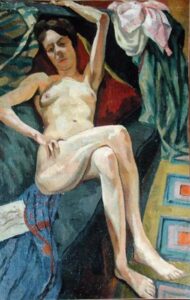
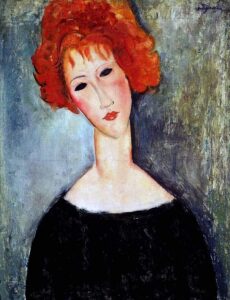
La Bella Chica Pelirroja (Retrato de Nina Hamnett) by Amedeo Modigliani
1917
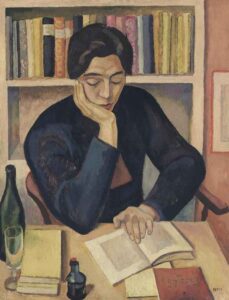
Portrait de femme
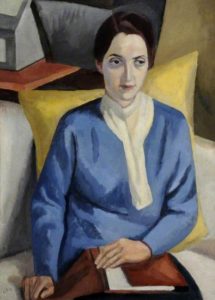
The student
Mac Tag

No Comments on "The Lovers’ Chronicle 14 February – be mine – verse by Shakespeare & Elizabeth Barrett Browning – birth of Nina Hamnett"